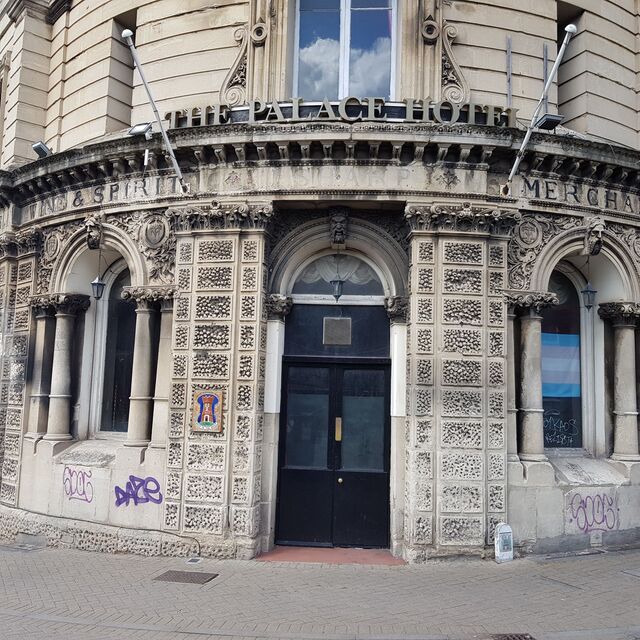╗ Main Index

» Search This Site

» Submit Update

» Contact Us


|
|

|
Home > Gloucestershire >
Bristol > BS2 >
Palace Hotel
Palace Hotel

|
|
Date of photo: 2019 |
Picture source: Ian Chapman |
|
|
|
|
|
|
The Palace Hotel was situated at 1-2
West Street. This grade-II listed
pub closed c2018. |
|
|
|
|
|
|
Listed
building details: |
A hotel, dating from 1869-70,
attributed to WH Hawtin for Thomas Morgan.
Description
Materials: The building is of limestone ashlar, with ashlar stacks to the
party walls, and a slate roof.
Plan: The building is a quadrant plan on a corner plot; with a range running
roughly north-west.
Elevations: It has three storeys with an attic above the quadrant and a
basement, and in total comprises a six-window range. The main elevation,
which is higher, follows the corner onto West Street, and the left-hand
wing, which sits in Lawford Street, has lower floor heights and a blank
right-hand party wall. To the central, curved section, the ground floor is
particularly highly decorated, with an arcade of semi-circular arched
windows and doorway, the wall surfaces articulated by vermiculated
pilasters, foliate capitals, entablature and modillion cornice. The first
floor has banded rustication, frieze and cornice and pilasters with sunken
panels, and a central window with a balcony of turned balusters; the second
floor has similar pilasters, frieze and dentil cornice. The second floor
window is flanked by Assyrian style herms. The left hand wing continues the
arcading at ground-floor level and there is a frieze above which runs the
length of the building and is inscribed IMPORTERS OF FINE WINES AND SPIRITS/
WINE AND SPIRIT MERCHANT. There are windows with eared architraves and lion
heads to the first floor and the second floor windows have swags to the
lintels. The steep, curved corner roof is flanked by tall coped walls with
stacks.
Interior: On the ground floor there is a bar servery within the corner
range; the bar back is formed from an arcade of semi-circular arches on
twisted brass columns with petal-relief capitols, echoing the form of the
windows. There are egg and dart and dentil mouldings, and moulded fruit
corbels at the arch bases. Behind the columns are pilasters with fielded
panels, and there are fielded panels on the bar cornice. There is an
elaborate ceiling cornice with egg and dart, flower-trellis and grape
mouldings. The north range has a lower floor level and is beneath an
inserted mezzanine floor. It has similar decorative motifs as the main bar.
There is a dog-leg closed-string stair with square newels and fielded
panelling beneath the banister. The mezzanine floor bisects the arched
windows of the north range, it has some fielded panelling and contains the
lavatories. There is a second stair to the north with a simple moulded and
chamfered newel post and stick balusters. On the first floor there are
elaborately moulded cornices and a ceiling rose. There is a cast iron fire
place with red tiling and painted slate surround with moulded corbels. On
the second floor there is a similar, less ornate fireplace. Within the attic
storeys the inside of the clock-face is exposed and there is access onto the
flat roof of the north range. Throughout the upper storeys of the building
are solid fielded panelled doors.
History
The former Palace Hotel, originally the Railway Hotel, was built in 1869-70
and was a speculative development by Thomas Morgan designed to take
advantage of a new railway station planned nearby. It is attributed to WH
Hawtin, based on the distinctive draughtsmanship of some unsigned plans. It
was intended to have hotel rooms arranged and decorated according to the
class of rail passenger who would stay in them: first, second and third. The
Palace remained in use as a public house until the early years of the C21,
when the property was sold, and the pub closed. The ground floor has been
reordered and has since resumed trading and the upper storeys, which have
undergone much subdivision, are used for domestic accommodation.
Reasons for Listing
The former Palace Hotel is designated at Grade II for the following
principal reasons:
* Architectural interest: the fašade is a highly ornate composition with
good surviving carved stonework
* Interior: the bar areas, though reordered, are striking and have elaborate
and opulent detailing
* Interior: there are remnants of the scheme to provide different classes of
rooms for the different classes of railway traveller
* Historic interest: it is a memorial to the unrealised railway extension |
|
|
|
Do you have any anecdotes, historical information, updates or photos of this pub? Become a contributor by submitting them here. Like this site? Follow us on

Make email contact with other ex-customers and landlords of this pub by adding your details to this page. |
|
|
|
|